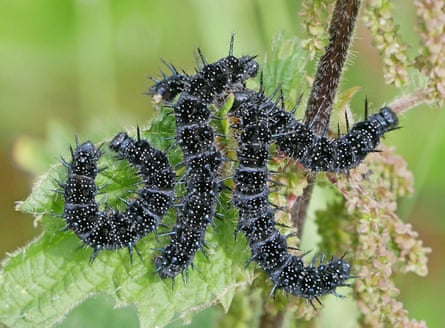The peacock butterfly caterpillars feeding on the stinging nettles in this sunlit glade seem restless, ready to pupate. Midnight black, speckled with a galaxy of tiny white spots, and armed with spines tipped with fine hairs that might deter a hungry bird, they look as menacing as nettle stings. They need to be, and they’ll need luck to make it beyond the next stage in their life cycle.
I can see parasitoids nearby – at least two ichneumon wasps, armed with long ovipositors that insert eggs with clinical precision, and tachinid flies too. The larvae of either could eat these caterpillars alive, if they get close enough to deliver their eggs. The peacock larvae twitch violently when they approach.
A few yards further along the verge there’s a pristine, freshly emerged peacock butterfly – a survivor from an earlier batch of eggs. Wings folded in a neat triangle, displaying only mottled black and umber undersides, it seems like a black hole among the purple florets that it probes with its proboscis.

Peacocks challenge the concept of butterflies as fragile, ephemeral creatures. If its luck holds, this one could live for nine months, before laying eggs and perpetuating the cycle of life. Between now and the first frosts it will nectar on knapweed, thistles, ivy and the juice of rotting brambles, accumulating fat reserves before hibernating in a hollow tree somewhere in the forest.
Until then, it too will need luck to avoid predatory birds – but it has shock, awe and false information in its favour. When I cast my shadow, it flicks open those wings and displays alarming blue fake eyespots set in a blood-red background. Just enough, maybe, to make a bird pause for long enough for the insect to make its escape, or at least deflect the blow away from the body. If this peacock emerges from hibernation on a warm spring day of 2022, it will, most likely, display tattered hind wings, evidence of near misses.
How many of today’s caterpillars with emerge into the spring sunshine next year? The odds against seem overwhelming, but their very existence reaffirms the adaptability and tenacity of life.

Comments (…)
Sign in or create your Guardian account to join the discussion